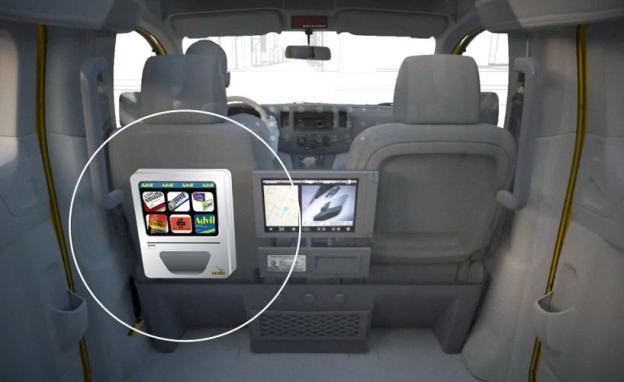
Even though the design for New York City’s “Taxi of Tomorrow” model already unveiled last week at the 2012 New York International Auto Show, it didn’t take long for designers to rethink ways to further improve the latest features to the transportation method.
While you may be able to charge your gadgets on your taxi ride thanks to the addition of USB outlets, designer Brian Shimmerlik thinks getting food on the go might be just as important. That’s why he has put together the TaxiTreats design which recently won the NYC Next Idea award from the 2012 New York Economic Development Corporation (NYCEDC) competition. A graduate of New York University’s Stern School of Business, Shimmerlik came to the idea when he envisioned that most people who take cab rides are usually in a rush or too tired to venture underground to the city’s subway system.
“Who hasn’t flown into New York, grabbed a taxi, and had a terrible headache?” Shimmerlik told DesignBoom. “Who hasn’t been late for a meeting, immediately regretted skipping breakfast, and suffered for the rest of the day? Who hasn’t left a meal and thought, ‘Wow, I’m self-conscious about my breath?’”
Under his design, the TaxiTreats vending machine would sell essential items such as snack bars, gum, energy drinks, and over-the-counter medication. It would be placed next to the touchscreen television that’s already installed in most cabs, and riders can purchase items by adding the total cost of their vending machine goodies to the sum of the taxi fare.
For winning the NYC Next Idea award, Shimmerlik and his project partner Tomas Grosskopf received $17,500 in funding and free office space to develop the concept to reality. While the design is yet to be approved by the city’s Taxi and Limousine Commission, the designers are hopeful the city will recognize the usefulness of this feature addition. After all, the two cite that public transportaion in foreign countries do a ton more to provide commuters high levels of time efficiency and convenience.
“In South Korea, commuters can shop for groceries while waiting for the subway and have their purchases delivered to their houses,” the students said in a questionnaire with NYCEDC. “NYC is technologically behind in this field and TaxiTreats wants to help NYC take the lead.”
Though it was not made clear, we assume the cab drivers would be responsible for restocking the vending machine and collecting the profits made from items sold. That, or the taxi management companies that rent out the vehicles might charge drivers extra fees for the upgraded car and they get to keep the profits from TaxiTreats. Either way, this incorporation of a vending machine seems a lot more useful than ones found in mall bathrooms. Besides, night shift cabbies might finally get a good use out of picking up intoxicated passengers craving drunk snacks and impulse purchases. We’re not speaking from, ahem, experience.


